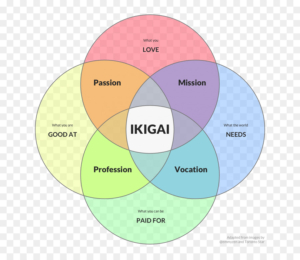Find and Develop Skills
Find and Develop Skills
Founder and Managing Member Ron Slee writes about how we can find and develop the skills we need in life. He brings the idea of Ikigai to bear on this crucial and timely subject.
How do we find and develop the skills to provide us the best possible life?
I have written often about happiness. From the philosopher Tom Morris and his book Plato’s Lemonade stand to The Art of Happiness at Work it is clear I want people to be happy in their lives. This I find out is a Japanese word – Ikigai. It is a word that is the meaning of life. It is what gets you out of bed in the morning.
Ikigai is the center of a circle that touches on four basic elements.
This is a very simple graphic, isn’t it? I would like everyone to be doing what they love, what they are good at and what the world needs. And clearly you need to be paid for it.
One of my first clients in 1980 was a cancer survivor. His name was Ron Miller. He was an extraordinary man in his early 30’s who gave Caterpillar fits. He was the largest broker of Caterpillar equipment in the world. He hired me to put him in the parts and service business so that he could feel he was a pseud CAT Dealer. He was quite force. My family and I were living in Vancouver, BC and I was working for Finning Tractor. I was effectively, or not, running the parts business for them in British Columbia and the Yukon Territory. We had fifty-three stores then and my job had become babysitting and politics and I neither liked nor was I any good at either. Ronnie successfully lured me away and that was the beginning of my consulting life. I remember as if it were yesterday sitting at the poolside in his building with my wife and daughter Caroline who was about four years old at the time. Ronnie had lost a leg to cancer and Caroline was fascinated with the “six-dollar man.”
I have met many gifted people in my life and Ronnie Miller was clearly one of them. He once told me that there were three words that he used to quide his life. Happiness, Effectiveness and Making Money. He said each day he tried to be happy and be effective and make money. I have never forgotten that lesson.
I am not as successful at living u0p to that as I would like but I continue to try. Notice he said “effective” not efficient. Two different words. He was all about doing the right thing. Not doint things right. That is a very telling statement. It fits into my mantra of doing your best, doing wha is right and honoring the golden rule. Simple things.
But let us return to Ikigai.
- What You love to do REQUIRES Passion and Mission.
- What The World Needs REQUIRESs Mission and Vocation.
- What You can be paid for REQUIRES Professionalism and Vocation.
- What You are Good at REQUIRES Passion and Professionalism.
The British journalist Malcolm Gladwell wrote a book called Outliers. In it he proposed that it takes 10,000 hours to be good at something and succeed at whatever it is. Aristotle said “We are what we do repeatedly.” There are many wonderful books written around the same theme. I was a swimmer in my youth. I swam hours and hours each day for years to get good at it. And I did get good at it.
When I started at a Caterpillar Dealership in Quebec, Canada, in 1969 I had the Senior partner from a consulting company spend one day a week, all day with just me, to show me and teach me about inventory management and systems. I had a passion to get good at what I did. Ad I did get good at it.
Along the way I had very talented people step up and help me get better at everything I did. Bob Kirk who was the “guru” of inventory management for Caterpillar took me under his wing. Larry Noe, one of the founders of Caterpillar Dealer Data Processing di the same. I don’t know why they did that but they did. Similarly, although later Roger Fay, who was responsible for the Caterpillar parts business in “Caterpillar Americas,” Canada, Mexico, Central and South America did the same. I will never forget those men. The truly “paid it forward.”
So, what was my passion? To do the right thing and to do things right. It started with swimming and my coach would watch where I put my hand in the water and wasn’t happy until I did it right. It continues today with everyone who influences my thinking about doing everything I do a little bit better. The “Kaizen” way.
That takes me to Professionalism. That is tough. It is a matter of opinion. I hate that. I don’t like opinions I like facts.
But let’s look at professionalism.
Professionals are:
- Competent
- Reliable
- Communicate well
- Poised
- Ethical
- Organized
- Accountable
As a consultant I have to be viewed by my clients in a specific manner:
- I have to have oral and written skills
- I have to have observation skills
- I have to have problem solving skills
- I have to have people skills
- I have to have organizational skills
- I have to have time management skills
- I have to be objective
- I have to be independent.
Once have become established I have to have references that will attest to my skills. That is my professionalism.
Let’s return one more time to Ikigai.
I am passionate about what do. It shows. I love it.
I have a mission. I have goals and purpose.
I have to be professional.
I have to make money.
In my life, professionally and personally I live Ikigai. I would hope that each of you would be in the same place. It is not easy and there are many roadblocks. But don’t give up. It is worth the pain and struggle to get there. I promise you that once you get there you will be happy and life and long and fruitful life.
The Time is Now.
Did you enjoy this blog? Read more great blog posts here.
For our course lists, please click here.




